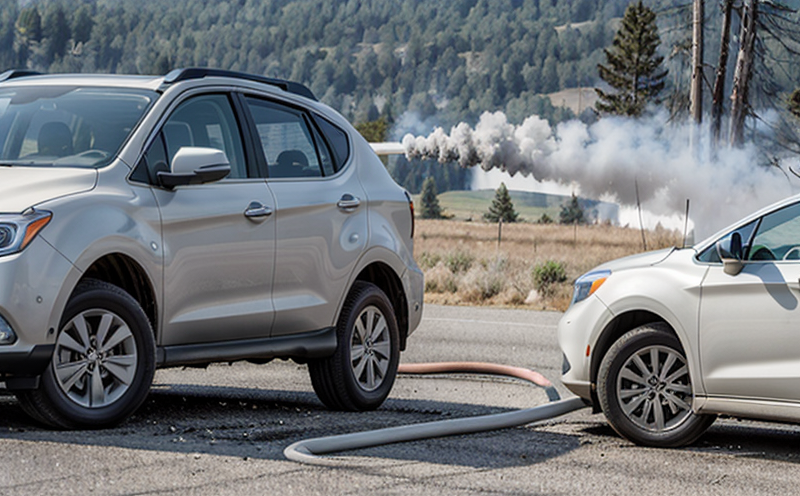EN 45545-2 Smoke Production Measurement for Railway Interiors
The European Standard EN 45545-2, which specifies fire safety requirements for railway applications, has introduced stringent measures to ensure the safety of passengers and crew in case of a fire. One critical aspect of this standard is the measurement of smoke production from materials used within railway interiors. This section focuses on EN 45545-2, which provides detailed protocols for determining the smoke density and toxic gas emissions produced by materials under specified test conditions.
The primary objective of this test is to evaluate how effectively materials contribute to reducing smoke production, a crucial factor in maintaining passenger safety during emergencies. The standard covers various types of interior furnishings used in railway vehicles such as seats, partitions, curtains, flooring, and ceiling panels. By quantifying the amount of smoke produced by these materials under controlled combustion conditions, manufacturers can ensure their products meet stringent fire safety regulations.
The test method described in EN 45545-2 involves subjecting specimens to a prescribed heating rate until they reach ignition temperature. Once ignited, the specimen is subjected to further heating at a constant rate until complete combustion occurs. During this process, sensors continuously monitor the concentration of particulate matter (PM) and gases like carbon monoxide (CO), hydrogen cyanide (HCN), and others that contribute to smoke density and toxicity.
The results from these measurements are then compared against predefined thresholds set forth in the standard. Compliance with these limits ensures that even if a fire breaks out, the level of harmful emissions will be minimized, thereby protecting passengers' health and safety. Additionally, this test helps manufacturers optimize their product designs by identifying areas where improvements can be made to enhance smoke mitigation capabilities.
For quality managers and compliance officers responsible for ensuring adherence to international standards like EN 45545-2, conducting regular testing is essential. It not only demonstrates commitment to maintaining high safety standards but also protects against potential liabilities associated with non-compliance. R&D engineers involved in developing new materials or improving existing ones can benefit significantly from this test by gaining insights into how different compositions affect smoke generation.
Proper preparation of specimens prior to testing is vital for accurate results. Specimens should be representative samples taken from actual products, ensuring they reflect the material composition used throughout the entire production run. Preparing these samples involves cutting them into uniform pieces that will fit within the specified dimensions required by the test protocol.
During the actual testing process, precise control over environmental factors such as temperature and airflow is necessary to ensure consistent results. This includes maintaining a constant heating rate during both the pre-ignition phase and post-ignition period. Sensors installed in the chamber continuously measure parameters like temperature, pressure, and gas concentrations throughout the test duration.
The output from this testing procedure consists of detailed reports summarizing all measured values, including smoke density levels expressed as optical density (OD) units or percentage obscuration, along with toxic gas emissions data. These metrics allow stakeholders to assess whether a given material meets the stringent requirements stipulated in EN 45545-2. Compliance with these limits ensures that even if a fire breaks out, the level of harmful emissions will be minimized, thereby protecting passengers' health and safety.
Incorporating this test into your quality assurance program provides several advantages. It allows you to identify potential issues early on in the design phase, enabling timely adjustments before full-scale production begins. Furthermore, it helps establish credibility with regulatory bodies responsible for enforcing fire safety regulations globally. Lastly, compliance with such rigorous standards enhances brand reputation among consumers who value product safety above all else.
Key Benefits of EN 45545-2 Testing:
- Ensures adherence to international fire safety standards
- Identifies areas for improving smoke mitigation capabilities
- Maintains passenger and crew safety during emergencies
- Protects against potential liabilities associated with non-compliance
- Optimizes product designs through real-world testing data
- Establishes credibility with regulatory bodies responsible for enforcing fire safety regulations globally
- Enhances brand reputation among consumers who value product safety above all else
In conclusion, incorporating EN 45545-2 smoke production measurement into your quality assurance program offers numerous benefits. By ensuring compliance with these stringent requirements, you can enhance passenger and crew safety during emergencies while also protecting against potential liabilities associated with non-compliance.





